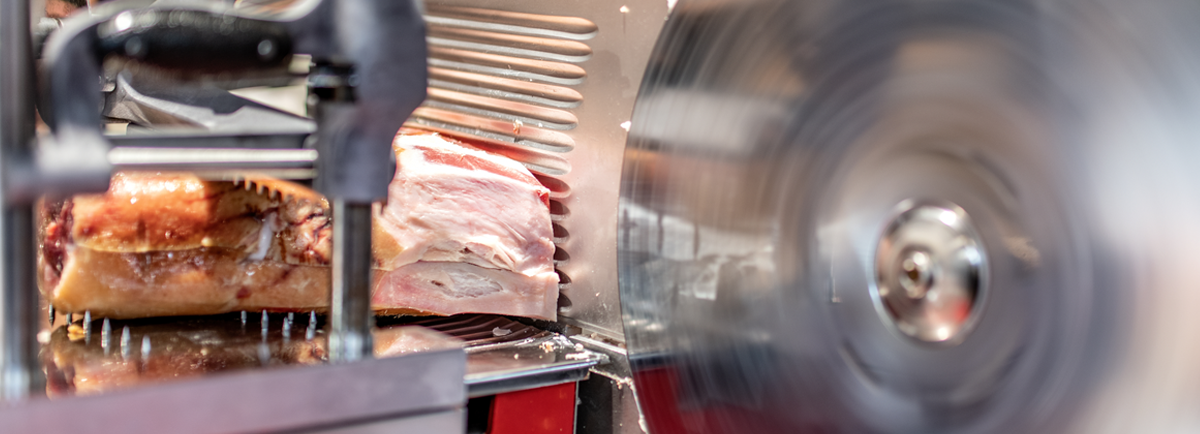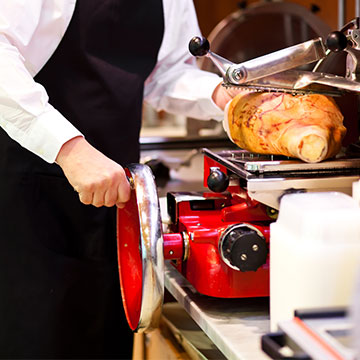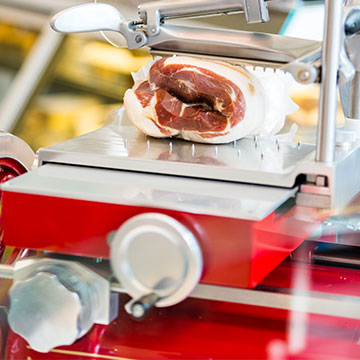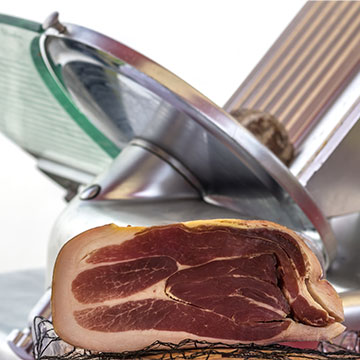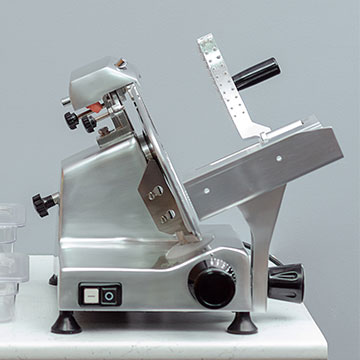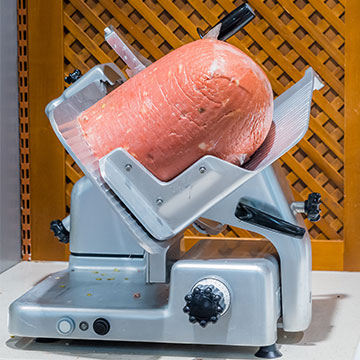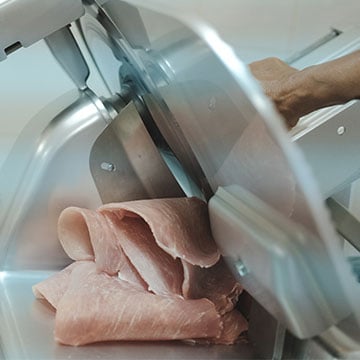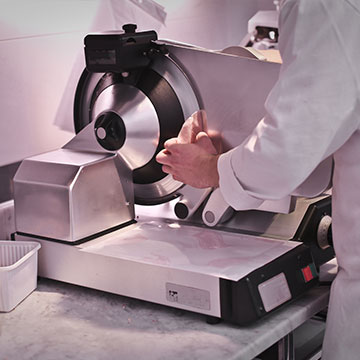A comprehensive guide to purchasing the best meat slicer, shedding light on some of the most challenging aspects for a less experienced user.
The Complete Guide to help you choose the Best Meat Slicer
by the Real Experts of Kitchen Equipment
“How do you want it cut?” “How many grams?” “So it’s two hundred kilograms and two. It‘s a little bit over. Is that ok?”
How many times have we heard these questions at the butcher’s or at deli counter of the supermarket?
Whenever we want to buy freshly sliced meat, whether it is bologna sausage, beef carpaccio, cooked ham or salami, this is the type of conversation we engage most frequently in with the deli owner. Choosing and buying freshly sliced meat is a very common habit both in Italy and in other parts of the world, and it involves a specific tool that is essential to carry out this process: the meat slicer.
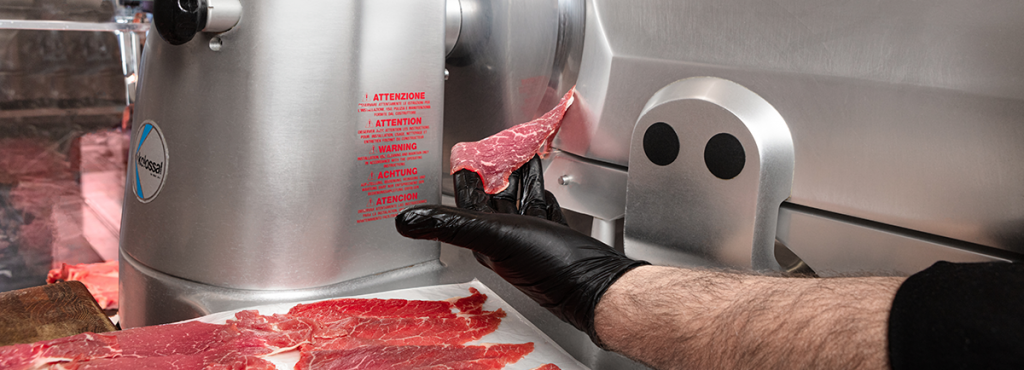
This very common machine was born in Italy in 1862 thanks to the Bolognese mechanic Luigi Giusti.
It spread all over the world thanks to Berkel, a well-known brand of meat slicing machines, which bought the patent and started industrial production in 1892, resulting in the further distribution of the machine known today.
The electric or manual meat slicer is an essential tool for all lovers of cured meats and salami who want to enjoy a fresh and flavourful cured ham or a nice bologna sausage in the comfort of their home, but also an essential equipment in some professional kitchens and other working environments.
It is with good reason that one may be inclined to think that, especially for the tastiest and most seasoned hams, slicing with a knife is by far the best way, but it also true that the convenience, working speed and precision of a meat slicer are not achievable even by a professional deli owner.
What about hams? Wouldn’t it be better to cut them with a knife?
Let’s say it’s a rule that is basically correct but doesn’t apply to all cold cuts. For example, for “sweet” hams, such as San Daniele or Parma ham, two well-known examples of the Italian gastronomy excellence, it is not necessary to perform the traditional knife cutting. On the contrary, according to some experts, it is preferable to use a slicing machine, as long as the blade is not too powerful to overheat the fatty part of the ham. In addition, it should be pointed out that the newer, more sophisticated and professional models of meat slicers are now able to deliver excellent slicing results without compromising the organoleptic characteristics of the product.
“Okay but one slicer is as good as another!”
That’s wrong! There are various types, each of which is specifically intended for certain products to be sliced (cured or semi-cured meats, cheese, bread, vegetables, dried meat…etc.), but it is not always easy to understand which one is best suited to the intended use and to one’s personal needs.
For this reason, this practical purchasing guide will help you choose the best meat slicer for your needs and will clarify some of the points that are more difficult for a less experienced user to understand, in order to provide all the essential knowledge needed to make an informed and conscious decision.
CONTENTS
1. The meat slicer
As we know, the meat slicer is a machine designed to cut various kinds of food products, especially cured meats and hams.
It proves to be essential for making quick, accurate cuts and in large quantities. The most important element of a meat slicer is the rotating blade which allows the product to be sliced. The latter is loaded onto a practical food carriage, which, by means of a fixed movement on a sliding guide, allows the product to be brought closer to the rotating blade, which will cut the food into a slice. The same process is repeated for each slice until the desired quantity is reached.
Apart from heavy-duty use, the meat slicer is an excellent tool for domestic use and there are many specific models for less frequent and intensive use, built with lighter materials, average-powered motors, smaller diameter blades and, above all, with a “warm-coloured” and more practical design. In fact, domestic models are generally more compact and smaller than heavy-duty machines, so much so that there are even some meat slicer models with a foldable support base, designed to take up as little space as possible and leave kitchen worktops free. These machines can then be easily stored in normal drawers or kitchen cabinets.
2. Power supplies
In addition to an initial distinction by level of use, it is possible to divide the category of meat slicers into two macro-groups, electric and manual.
2.1. Manual meat slicer
The manual meat slicers, also known as “flywheel meat slicers”, are very similar to the very first models of slicing machines and are ideal for those who intend to place the machine in cellars or places without electricity or power sockets.
As they do not need electricity to function, these models are powered manually by turning the flywheel which consists of a wheel with a crank handle that allows both to slide the food carriage, on which the food to be sliced is loaded, and to turn the rotating blade
Like we have said before, these models are particularly suitable for high-quality cuts of cold meats.
Although aesthetically pleasing and with a vintage design, these models are much bulkier than the electric type and, of course, much slower (which is why they are not recommended for intensive heavy-duty or industrial use, where a high working speed is required).
2.2. Electric meat slicers
Electric meat slicers are undoubtedly the most popular and most widely used types in the world because of their ease of use, straightforward operation and, above all, the working speed.
These models come with a very simple functioning: they are powered by an electric motor connected to the power socket, which allows the blade to rotate automatically at a stable speed.
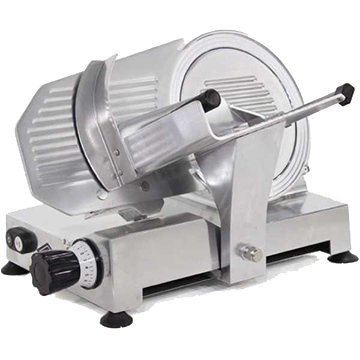
CELME Family 250 Electric Meat Slicer
with 250 mm Blade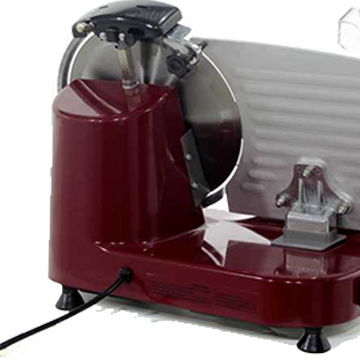
Power cable 
Reber TF25 Electric Meat Slicer
with 250 mm Hardened Blade
Once connected to the electrical outlet, the machine is ready to be used in three simple steps:
- Properly position the food to be sliced on the food tray, using the practical food pusher.
- Turn the machine on by pressing the start switch, thus activating the motor that rotates the blade.
- Guide the food carriage on which the food to be sliced is loaded towards the rotating blade.
3. Types
Another element that draws a distinction between the various meat mincer models is the blade angle. This apparently insignificant aspect is, however, very important and relevant when choosing a slicing machine.
Depending on the blade angle, two main types can be distinguished: vertical meat slicers and gravity meat slicers.
3.1. Vertical meat slicers
The peculiarity of these models lies in the position of the blade, which is mounted perpendicularly to the base of the slicing machine (i.e. vertically).
These models require special attention from the operator, who must guide the slice from the blade to the food carriage located beyond the cutting line. In this process, the user needs to use a special tool, i.e. the pliers, to prevent the running blade from coming into contact with the fingers, which could lead to an unpleasant injury.
Models of this type are mostly professional and are particularly recommended for cutting fresh, cooked and even frozen meats (but only certain models with higher performance and particular types of blades).
3.2. Gravity meat slicers
Unlike vertical models, gravity meat slicers are equipped with a blade positioned at an outward angle (about 45°), allowing the slice to slide, or rather “fall” by the force of gravity into a safe position away from the blade.
This system increase the safety level of the blade itself, compared to the vertical type, and is particularly suitable for domestic use and less experienced users.
Gravity slicing machines are recommended for cutting cured meats, cheeses, vegetables, bread and other foods.
4. Main features
Before purchasing an electric meat slicer, it is a good idea to take into consideration some very important technical aspects, so as to choose a product whose features are consistent with the use we want to make out of it.
4.1. Engine and transmission
One of the first aspects in terms of importance to assess before moving forward with the purchase is the motor. This can have two distinct types of transmissions:
- Direct transmission, that is, fitted in those models in which the motor itself drives the blade directly;
- Belt transmission, in which the energy released by the electric motor acts on the belts, which in turn operate the rotating blade.
Meat slicers with direct transmission are very reliable and are able to perform neat and precise cuts. In addition, they can boast a high level of efficiency and prove to be more powerful than slicing machines with belt transmission. This is because some models with belt transmission can waste part of the energy needed to power the blade, causing power drops that might affect the final result.
Not surprisingly, belt-driven slicing machines are much more cost-effective and, although they maintain a good level of final yield, their quality level is slightly lower than other models with direct transmission, which are more performing and more suitable for professional use.
4.2. Power
The power of the motor of a meat slicer is a fundamental element for a machine with a good performance.
It goes without saying that the more powerful the meat slicer, the more efficient it will be, in terms of cutting quality and ease of use. This is because the power directly affects the rotation speed of the blade and a low-powered motor will not be able to slice food in the same way as a higher-powered machine.
This means that the cutting quality depends on the motor power, but also on the type of slicing that the user wants to do.
In short: the higher the power of the machine, the greater the number of types of food that can be sliced with it.
Attention! It is important to make a necessary clarification so as to avoid any possible misunderstanding:
before assessing the power, it must be taken into account the intended use the user wants to make of the meat slicer, then, based on this, choose the machine that is most suited to his/her needs.
In fact, in addition to the machine’s performance, engine power also has a considerable impact on consumption, which is why it should be evaluated carefully.
For example:
if the user needs a normal slicing machine to use it occasionally and for just a few minutes, then it is not necessary to purchase a heavy-duty high-powered tool, as it will only be wasting electricity unnecessarily and impact on consumption in the long run.
On the other hand, if the user needs a machine that has to withstand long and continuous working sessions, then a meat slicer with good power will be able to carry out the slicing work without the risk of overloads or breakages.
In summary, a good heavy-duty or semi-professional slicing machine must have a power rating of between 150 Watts and 400 Watts, while for domestic use it is better to move towards machines with a power rating of less than 150 Watts, but which are still above 100 Watts (that is the minimum power for these machines which are nevertheless very performing).
4.3. The blade
Another key aspect of slicing machines is obviously the blade.
There are various types that mostly differ in size (meaning the diameter of the blade), the position (vertical or with an outward angle) and the edge (smooth or toothed blades).
First of all, it is necessary to assess the product to be cut with the machine, as this will determine which blade is most suitable. The blade diameter should also be included in this assessment.
For example, a large product, such as bologna sausage or ham, will need a “large” blade with a good diameter (greater than 22 cm), so as to be able to slice smoothly across the whole height of the food; on the other hand, for cutting smaller products, such as salami, pork loins and so on, a medium-small diameter blade (19-22 cm) will be sufficient.

ALA 2000 GP 195 Silver Meat Slicer
with 195 mm Small Blade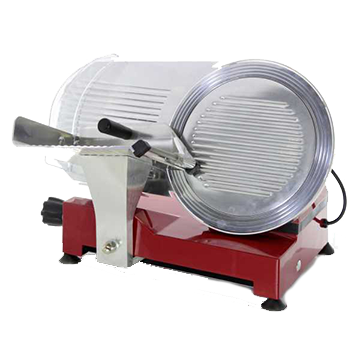
AgriEuro Premium Line MS300 Meat Slicer
with 300 mm Heavy-duty Large Blade
It is worth recalling that, as we have specified above, a large blade that has to slice large quantities of food requires a motor that is up to the height of the cut to be made.
As far as the edge is concerned, there are two main types: toothed or smooth.
The smooth blade is the most common and widespread version among meat slicers, as it is a blade suitable for cutting the majority of products.
This “universal blade” is able to make a precise and clean cut, without fraying less seasoned or generally less hard goods.
On the other hand, we have toothed blades, which are particularly suitable for cutting hard foods, such as bread or certain types of cured meats and cold cuts.
The special feature of this blade is indeed the toothed edge, which allows it to slice the product by penetrating the harder surface layer.
Another difference between these two types of blade concerns sharpening, which is much simpler for smooth blades and much more complex for toothed blades, which, due to their shape, require a particular type of sharpening, aimed at filing each individual tooth one at a time.
4.4. Materials
The importance of the machine’s construction materials mainly concerns three parts: the blade, the base and the back plate.
A good blade must be resistant to corrosion and must maintain its sharpness after each use.
The top of the range consists of slicing machines with stainless steel, anodised steel or chrome-plated steel blades, ideal for heavy-duty machines that usually withstand a greater workload and more complex cuts.
Next up are hardened steel blades, which are less expensive than stainless steel, but still reliable and durable. This type is the most widespread and it is fitted on most models of meat slicers, especially those for domestic use.
As for the black plate and the base, there are models built with various materials, including: plastic, metal and obviously, steel.
Models with a plastic machine body are obviously less durable and less stable than metal or steel models, but they have the great advantage of having a much more affordable cost and above all of being more lightweight and easier to move around.
Slicing machines with plastic housing are mainly intended for limited, hobby use. Metal models are obviously sturdier than plastic ones, but the top of the range is only found in steel models, which are more reliable and more suitable for professional use.
One aspect to consider when evaluating machine materials is the overall weight. It goes without saying that models in steel or metal are heavier and less comfortable when transporting or moving, compared to models made of lighter materials, such as wood or plastic.
On average, the weight of an electric meat slicer for domestic use ranges between 4.5 and 9 kg, while more performing models intended for professional use, which are usually made of more resistant materials, can weight up to 25 kg.
5. Maintenance and cleaning
In order to have a machine that maintains its performance over the years, beyond the materials, it is very important to carry out a correct machine maintenance.
In addition to hygiene and all the rules to be respected in the food sector, the maintenance and cleaning of the machine is essential to preserve the blade and extend the life of the equipment itself.
The first fundamental rule concerns hygiene: a meat slicer of any type must be meticulously cleaned and disinfected after each session of use, in order to avoid any proliferation of bacteria and germs on the surface that will come into contact with the food.
The blade is the part of the slicer most prone to collecting “dirt” and for this reason it should be systematically and carefully cleaned and sanitised.
To do this, simply spray some sanitising product (or a suitable degreaser) on the blade and leave it to act for a few minutes before rinsing it several times with a damp cloth. Once this is done, it is very important to dry the blade thoroughly to avoid oxidation.
For a deeper cleaning, it will be necessary to disassemble some parts following the instruction manual and perform the same treatment carried out on the blade also on the other elements.
As for the smaller components, they can be soaked for a few minutes in a basin with a solution composed of vinegar and lukewarm water, then rinsed, dried carefully and finally reassembled.
Finally, there are some routine maintenance operations to carry out on the machine. The components that need special attention are the blade, the sliding guides and the drive belt (if we own a model fitted with this kind of transmission).
So, remember to:
- Keep the blade sharp;
- Keep the sliding guides of the food carriage well lubricated;
- Monitor the status of the belt and, if necessary, replace it in case of malfunction or loss of power.
6. Safety
When using an electric slicing machine, it should be always kept in mind that it is a tool that must be operated and cleaned safely, respecting some fundamental precautions for the user’s protection.
For example, to take the freshly cut slices from the machine, it is best to use a practical pair of pliers that will help to keep a safe distance from the blade in action.
In addition, in order to be sure to have a “safe” tool in the house, models equipped with a locking system, i.e. a system created to prevent the slicer blade from working without the presence of an operator, can be evaluated.
Last but not least, when purchasing a meat slicer, do not forget the CE certification, which ensures that it fully complies with EU safety standards.
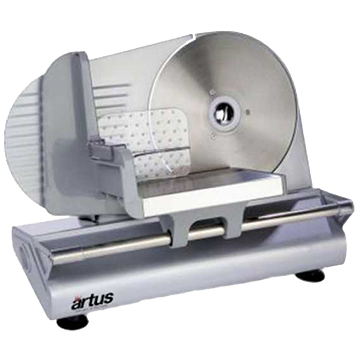
Artus AF22 Meat Slicer
with CE domestic marking
CELME FAP 300 Meat Slicer
with CE professional
Machines with CE domestic marking are suitable for a purely domestic and non-continuous use, while those with 60.335/60.335.2.64. EN 1974 certification, that is, slicing machines with CE professional, are the only ones suitable for use in professional working environments.
The latter, compared to models with CE domestic marking, offer more precise thickness adjustment, greater safety for the disassembly of the blade and the food carriage and superior handling.
7. Brands
Before proceeding with the purchase of a meat slicer, it is a good idea to take into consideration what are regarded as the leading brands in the manufacturing of these machines.
As with other types of product, choosing a well-known and trusted brand means to rely on high-quality, safe machines. The brands worth assessing when purchasing a slicing machine, whether domestic or heavy-duty, are the following: Reber, C.EL.ME., Ritter, R.G.V., Graef, Severin, Berkel and H.Koenig.



